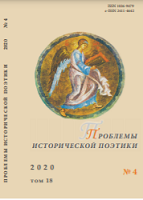Семантика евангельского эпиграфа к роману «Бесы» Ф. М. Достоевского
Semantics of the Gospel Epigraph to F. M. Dostoevsky’s Novel Demons
Author(s): Anna Aleksandrovna SkoropadskayaSubject(s): Christian Theology and Religion, Studies of Literature, Semantics, Russian Literature, 19th Century
Published by: Петрозаводский государственный университет
Keywords: Dostoevsky; Plato; the demoniac; frenzy; the parable of the Gadarene demoniac;
Summary/Abstract: The article is devoted to the review of the gospel epigraph to the novel Demons from the point of view of the ancient tradition. The parable of the Gadarene demoniac, which correlates with the title and the figurative and semantic content of the novel, actualizes the concept of devilry, the nominative field of which includes the lexeme demon. In addition to historical and literary content, this lexeme has a deep historical and philosophical meaning that goes back to the demon of Socrates described by Plato. The mythological δαίμων and the Socratic τὸ δαιμόνιον possess generally positive semantics, but in the Christian tradition, which replaced antiquity, the nomination demon began to denote an evil demonic force that seeks to take over a person’s soul. The Russian lexeme bes, as well as the words derived from it - Russian besnovaty and besnovanie (demoniac and possession by demons), is synonymous with demon, which is of a Greek origin. Demonic possession, which manifests itself outwardly in the loss of reason, is equated with spiritual illness. For such States, Plato uses the words μαίνομαι and μανία, the root of which is present in the words mania and maniac, denoting obsession with a certain idea. In both ancient Greek and Russian, this root has a negative connotation. Thus, demonic possession, described in the gospel as a spiritual illness, goes back to the ancient concepts of δαιμονίζομαι and μαίνομαι. This perspective allows us to reveal additional layers of meaning in the gospel epigraph and, as a result, in the novel itself.
Journal: Проблемы исторической поэтики
- Issue Year: 18/2020
- Issue No: 4
- Page Range: 209-228
- Page Count: 20
- Language: Russian

